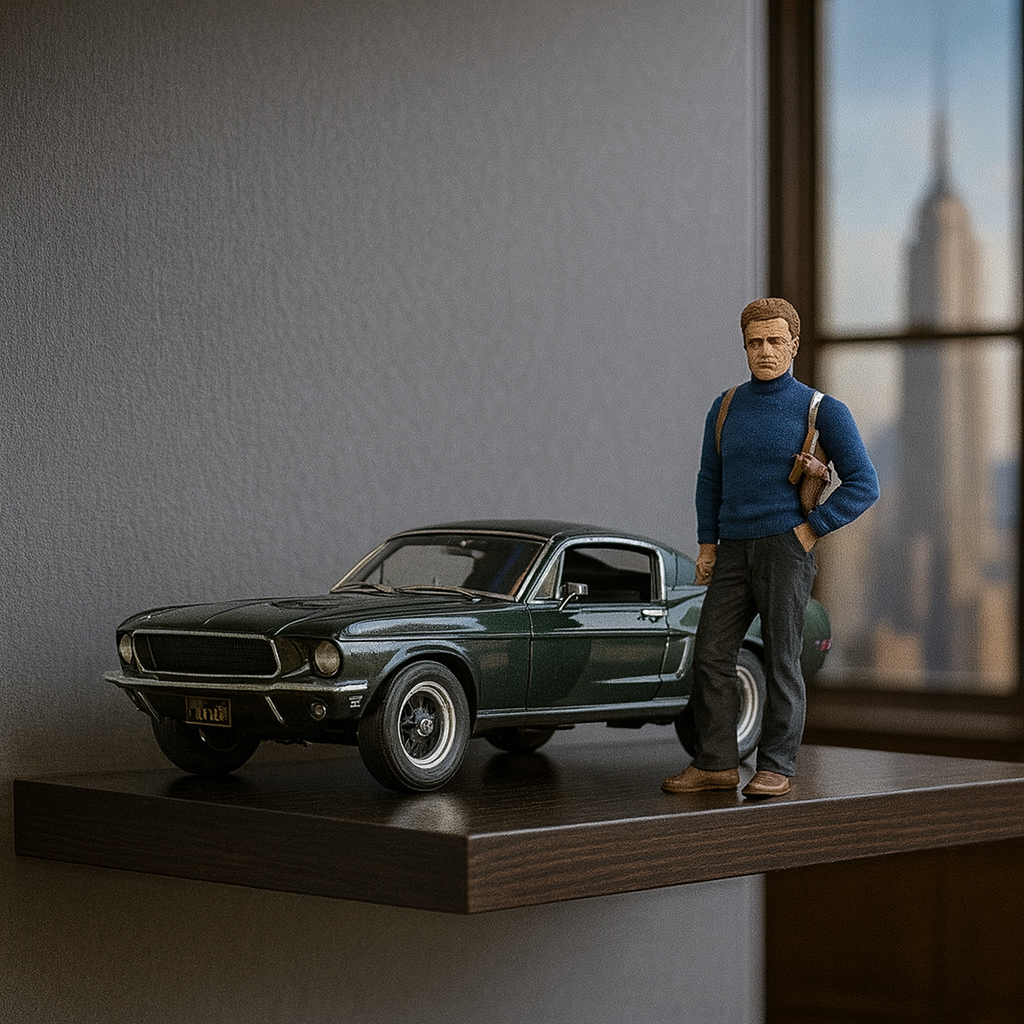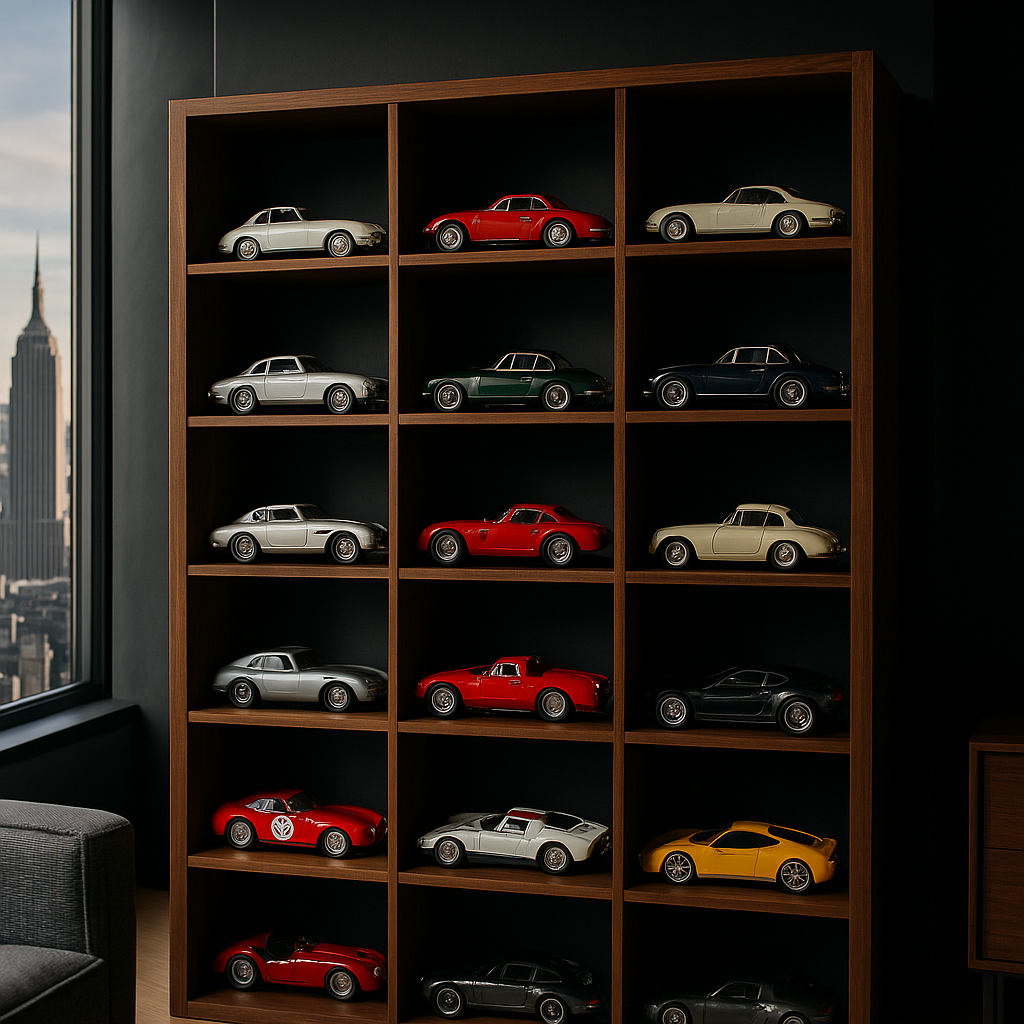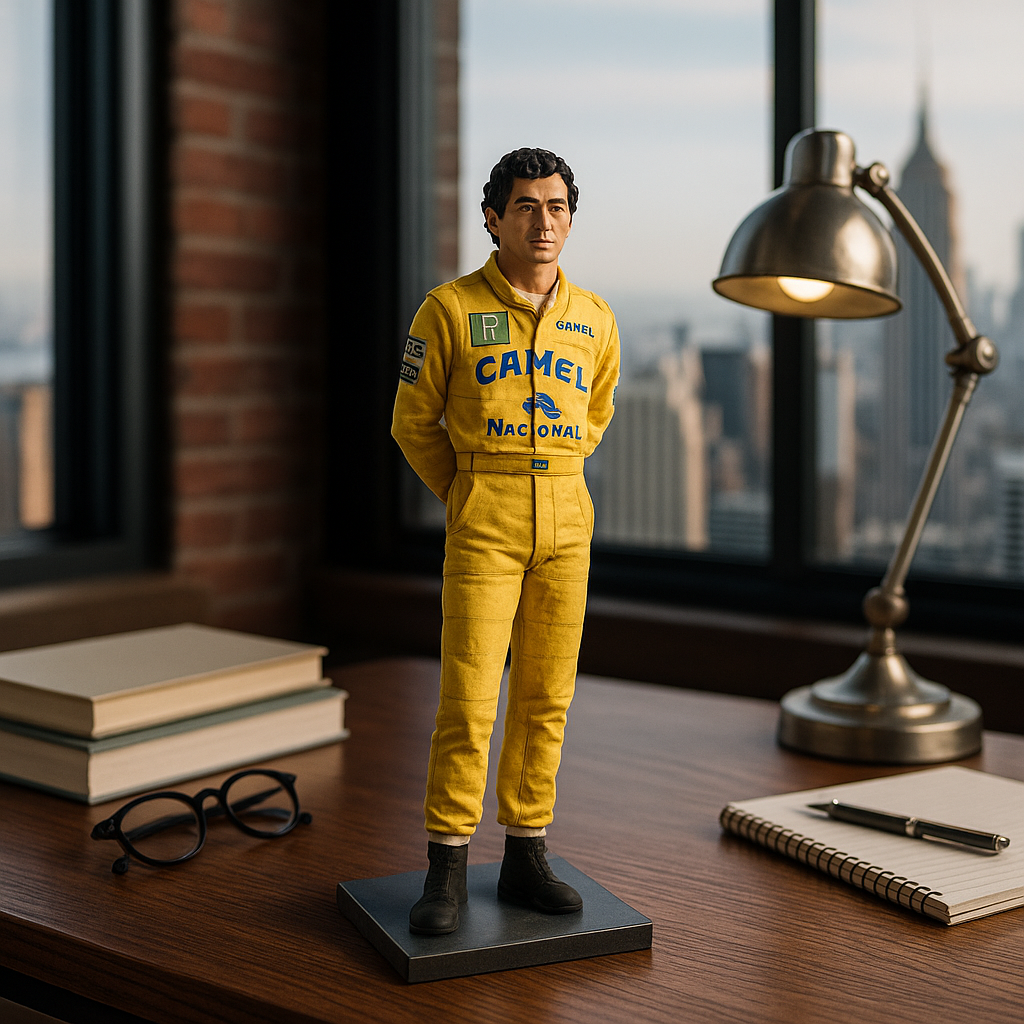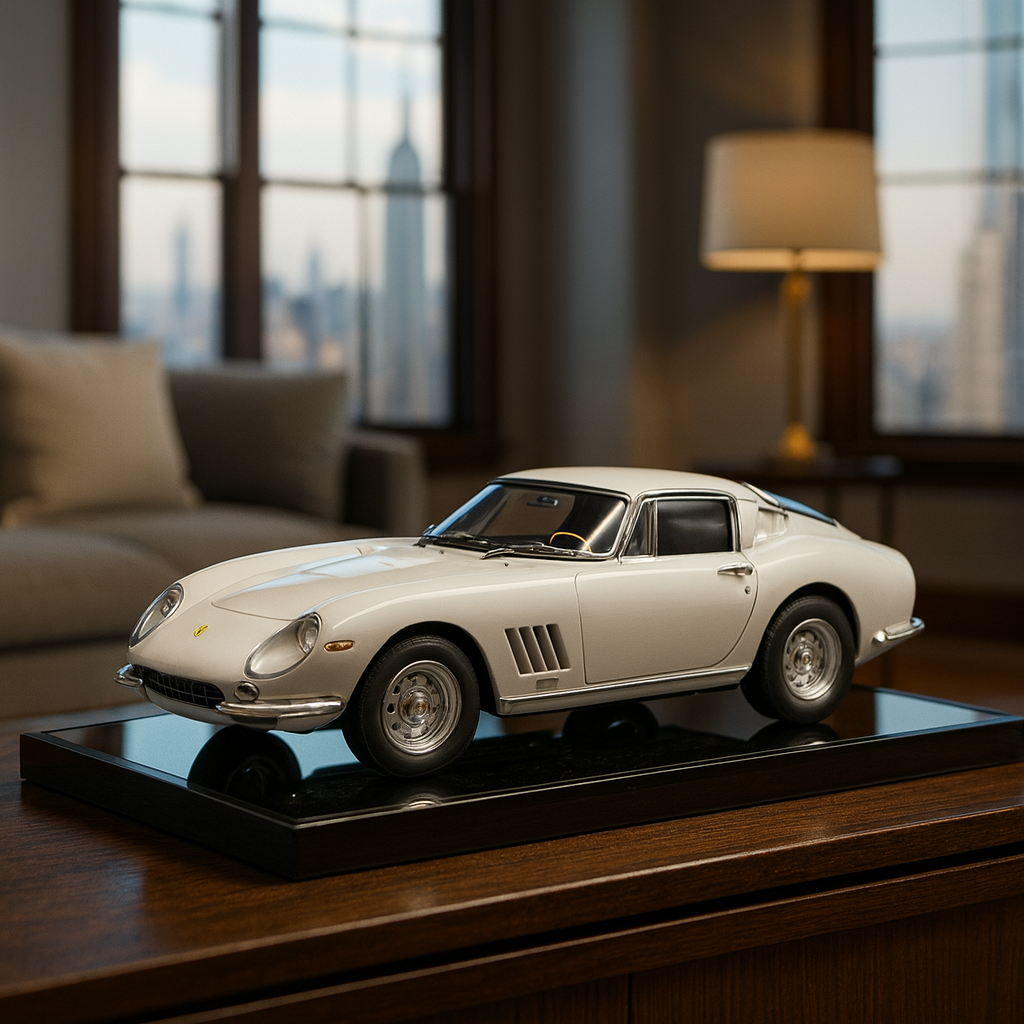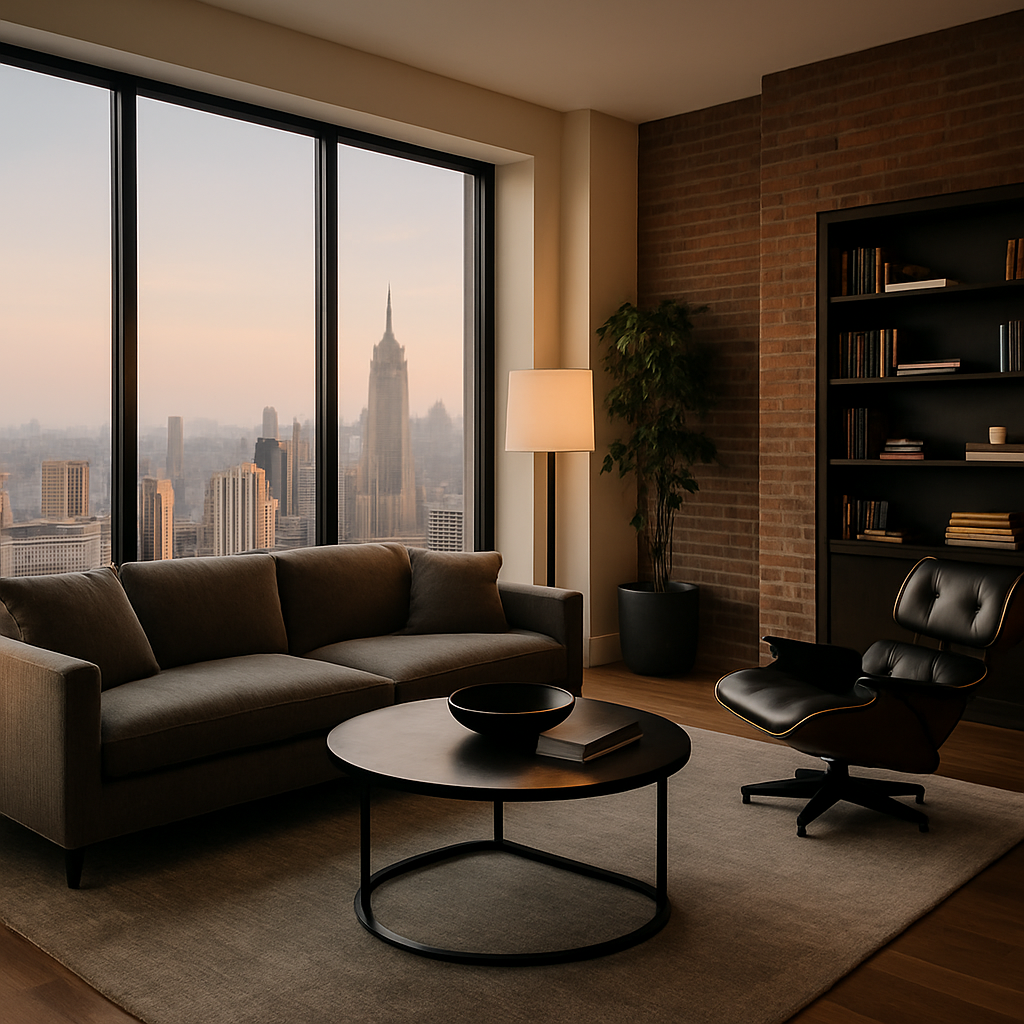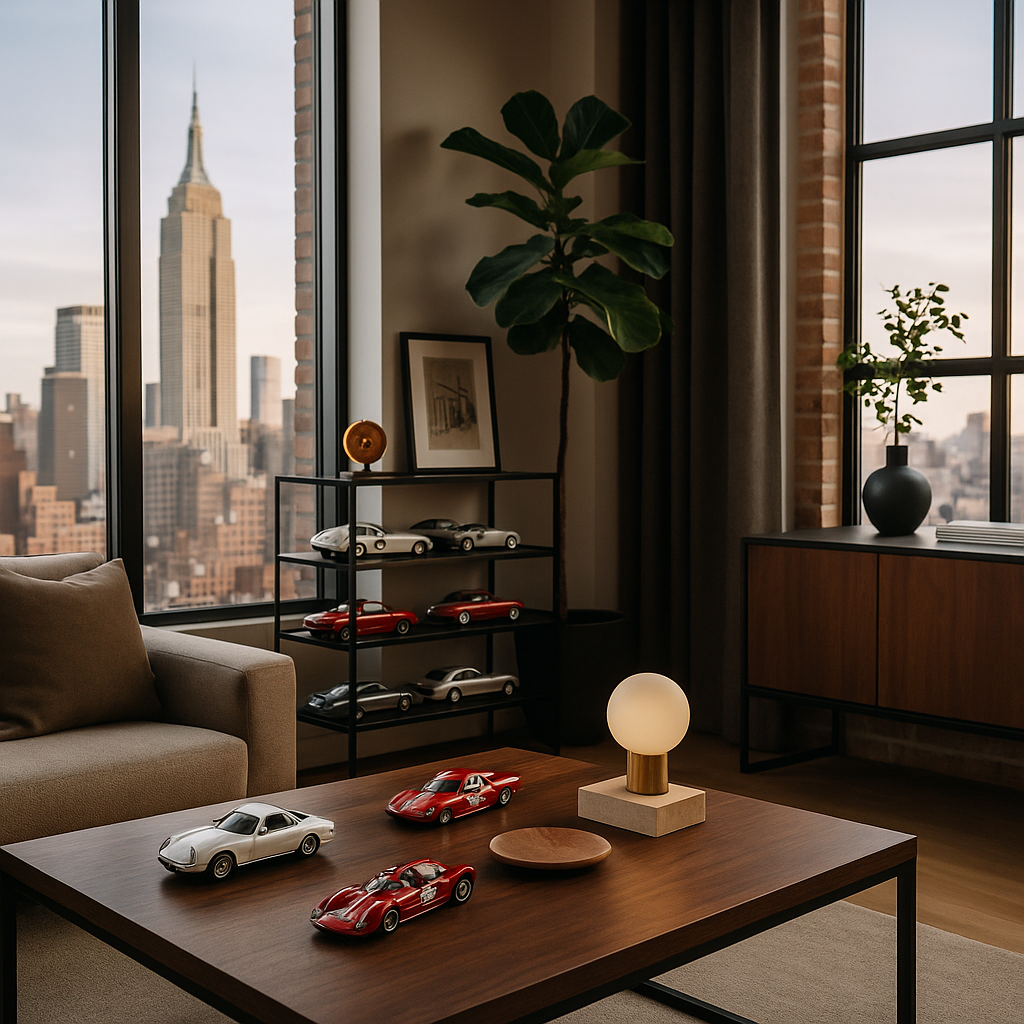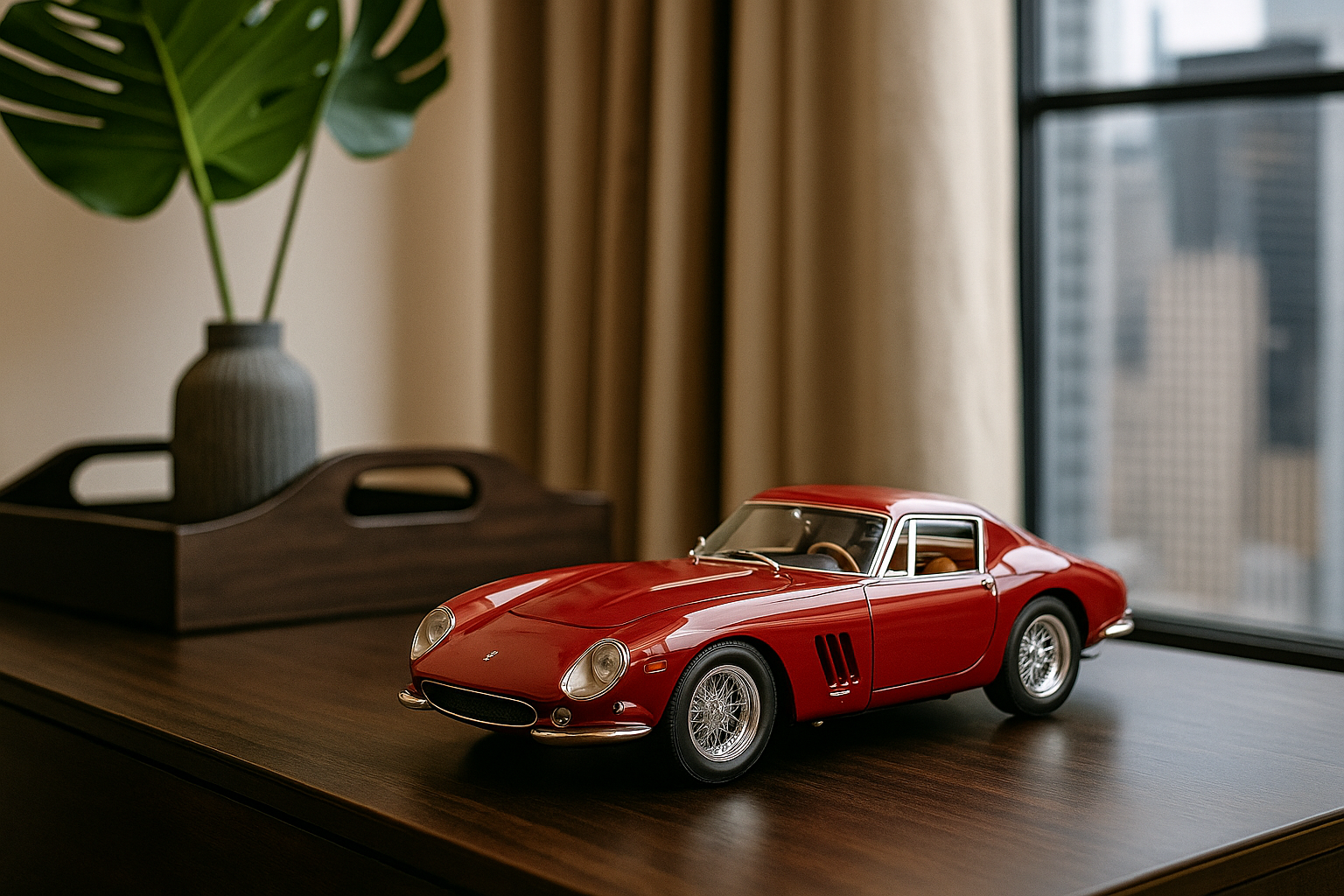
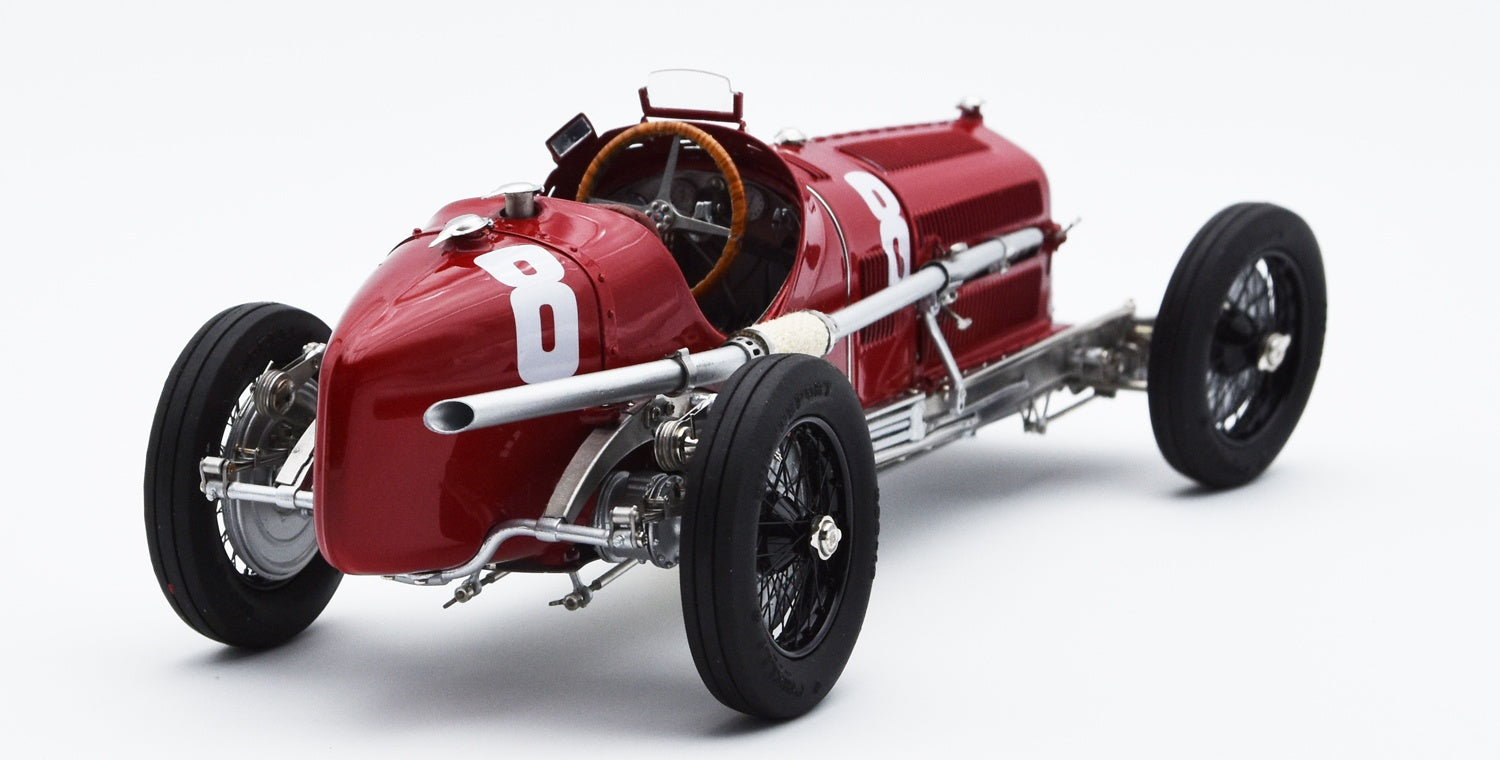
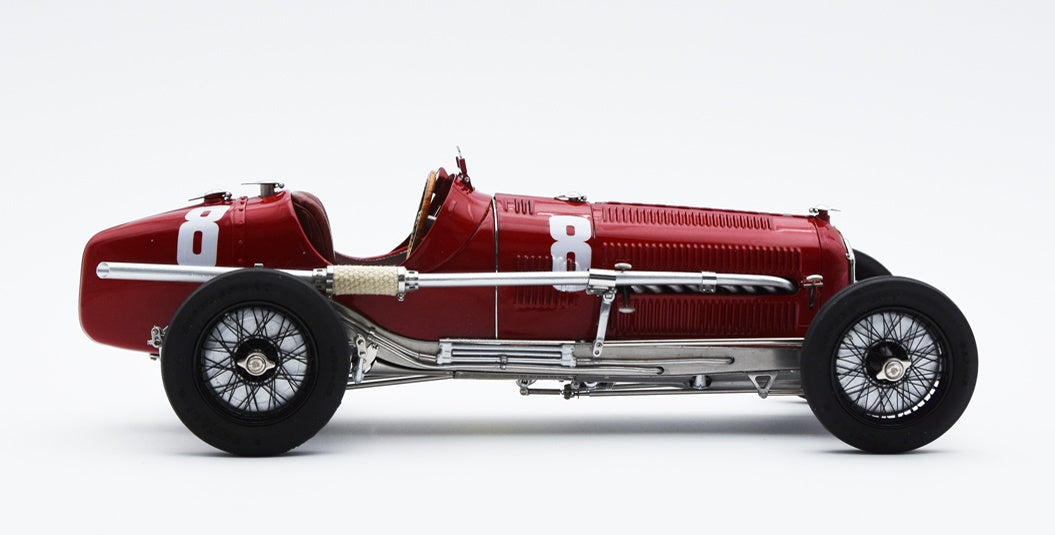
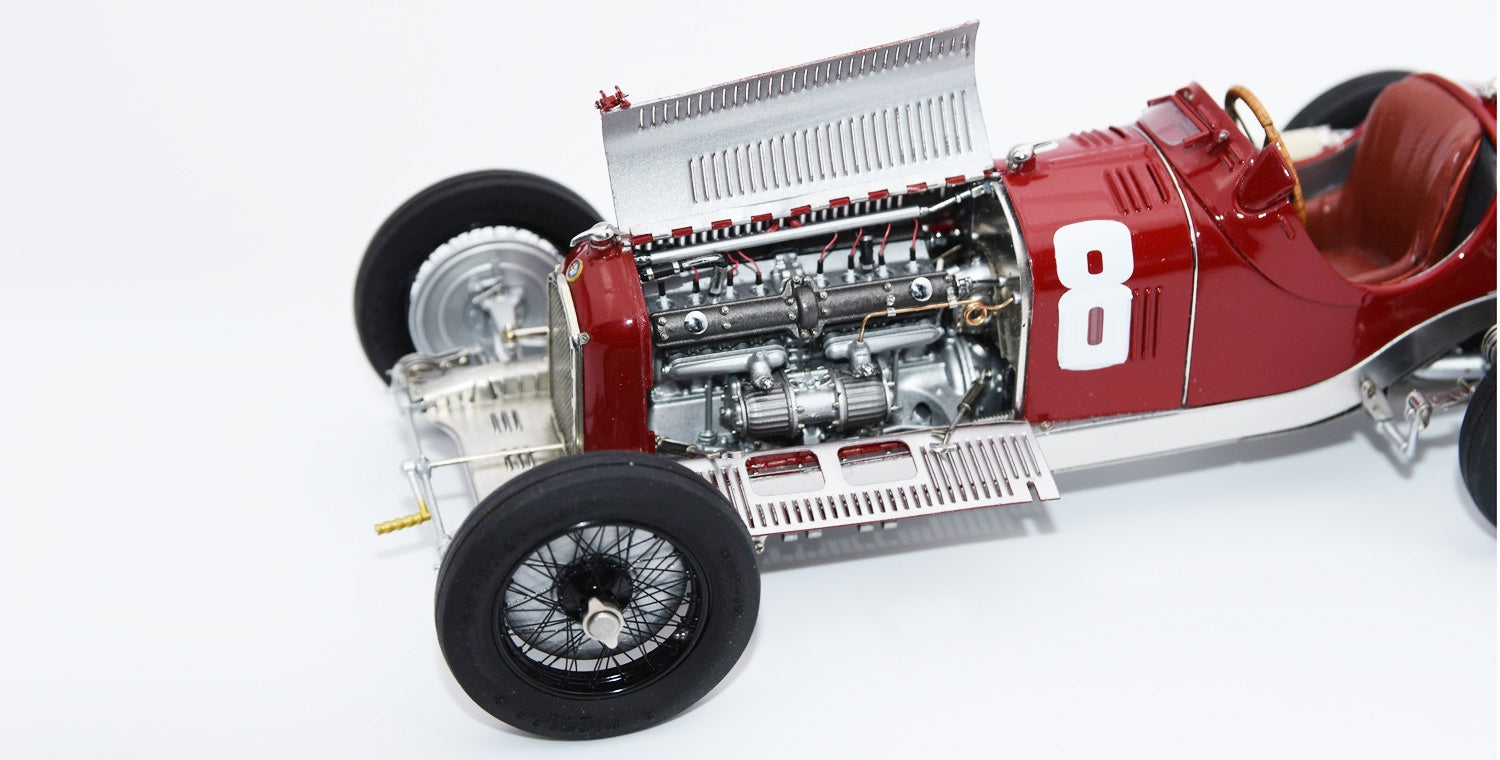
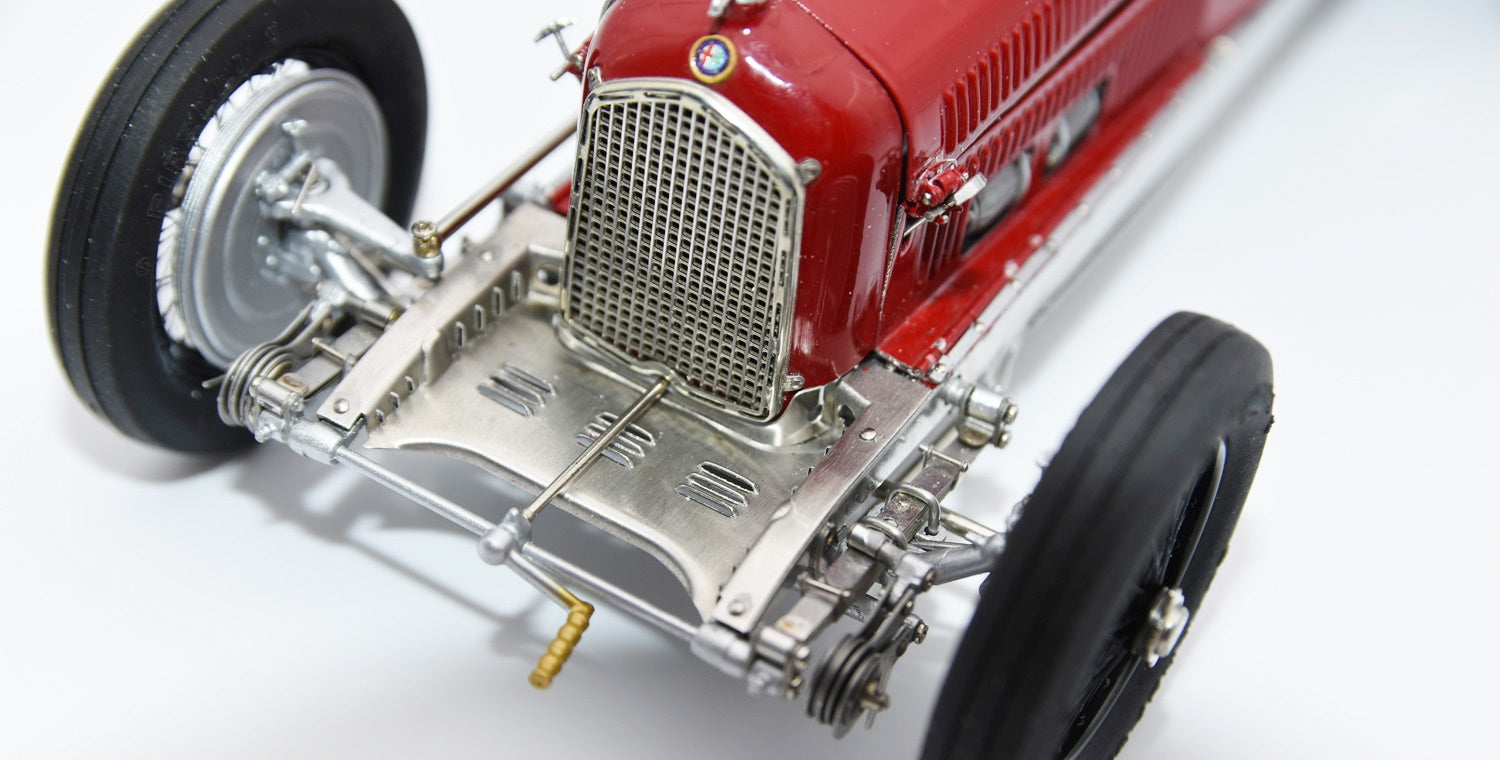
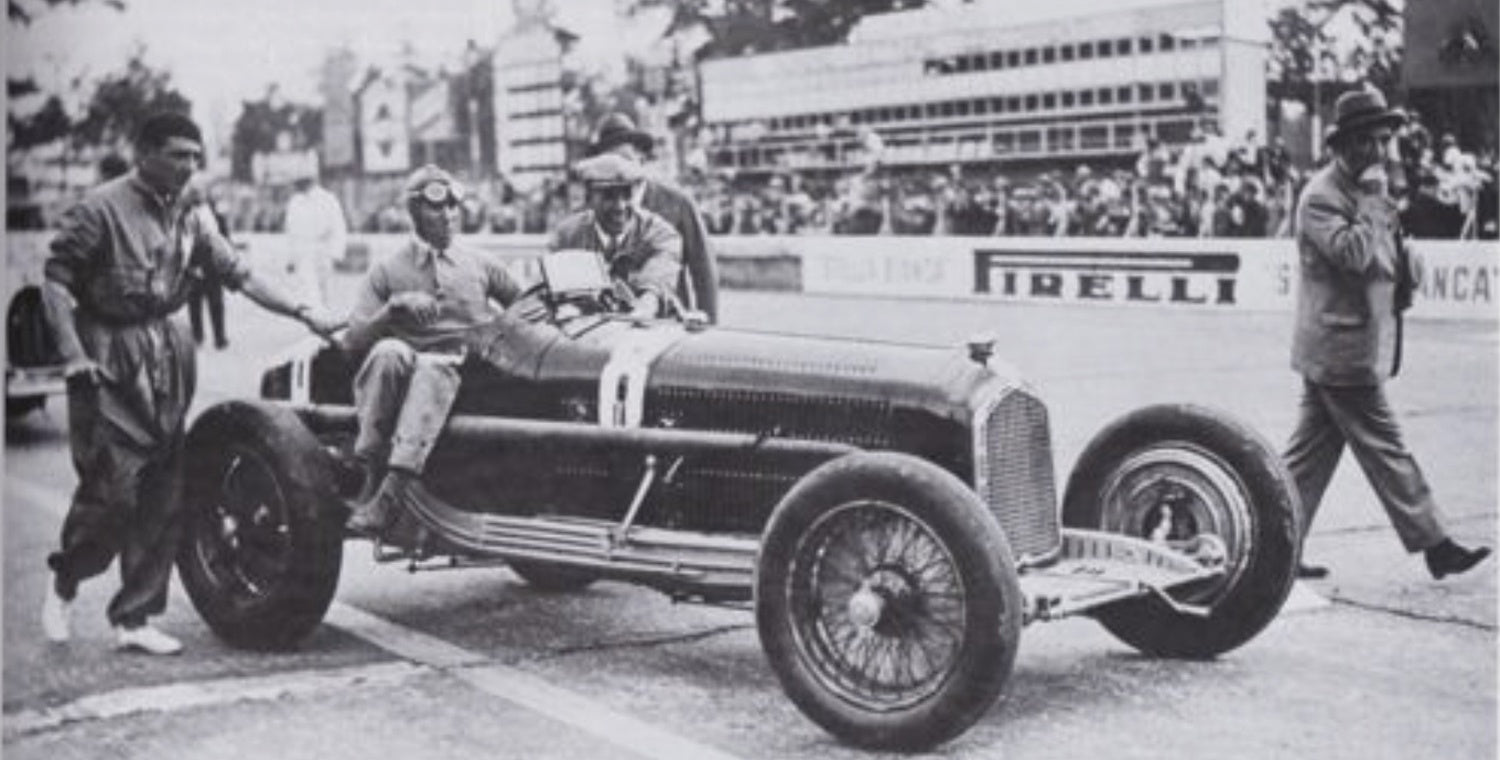
CMC Alfa-Romeo P3 #8 Tazio Nuvolari, winner Italian GP 1932

Description
The Alfa Romeo Tipo B was the most successful single-seater Grand Prix racing car of its time. Alfa Romeo built and fielded it between 1932 and 1936. Initially as an Alfa Romeo works car, later, after Alfa Romeo took over its racing activities, it was marketed under the Scuderia Ferrari label. Designed by legendary designer Vittorio Jano, the car was based on the equally legendary Alfa Romeo 8C models. The P3 was Alfa Romeo's second single-seater after the Tipo A monoposto of 1931.
The 10th Italian Grand Prix was part of the 1932 European Championship. Fifteen of Europe's best drivers participated, with the competition mainly between Nuvolari in a new, lightweight 2.65-liter Alfa Romeo Tipo B and Fagioli in a 16-cylinder Maserati. Frequent position changes made this record-breaking race very exciting to watch. The main competitors included Chiron and Varzi in Bugattis, Nuvolari, Campari, Borzacchini, and Caracciola in Alfa Romeos, and Fagioli in a Maserati. Ultimately, Alfa Romeo proved superior and won. On June 5, 1932, the 10th Italian Grand Prix took place at the famous 10 km Autodromo di Monza (4.5 km oval high-speed track plus 5.5 km asphalt track). Together with the French and German Grands Prix, it counted towards the European Championship, and all three events were to be run according to the same 5-hour formula. The regulations permitted participation without weight or power restrictions. Single-seater racing cars were now permitted, and the Societá Anonima Alfa-Romeo debuted its 8-cylinder 2650 cc single-seater (P3). Tazio Nuvolari and Giuseppe Campari would drive these brand-new single-seaters, while Mario Umberto Borzacchini and Rudolf Caracciola would drive the older 8-cylinder 2300 cc Monza cars. Bugatti fielded its best drivers, Louis Chiron and Achille Varzi, in two of its 5-liter models, which had demonstrated their incredible speed in the Avus races. Officine A. Maserati was the third factory team to participate in the race, entering the gigantic 16-cylinder 5-liter Maserati with Luigi Fagioli. In addition to the three factory teams, several private drivers also participated, including Hans Stuck in his Mercedes, the gifted Bugatti drivers René Dreyfus, Marcel Lehoux, Jean-Pierre Wimille, Emilio Romano, and Guglielmo Peri, Clemente Biondetti in his Special MB car, and Scuderia Ferrari drivers Pietro Ghersi and Eugenio Siena in two Alfa Romeo 2300 cc Monzas, among many others. The race was scheduled to start at 9:30 a.m. and finish at 2:30 p.m. Spectators numbered between 50,000 and 100,000. Fifteen of the registered participants made it to the starting grid. When the checkered flag was lowered at 9:42 a.m., the cars took off with a thunderous roar of superchargers and a thick cloud of bluish smoke. After 3:34 minutes, Nuvolari in an Alfa-Romeo Tipo B completed the first lap ahead of Chiron in the large light blue Bugatti and Campari in the second sleek Tipo B P3. On lap two, Nuvolari was still in the lead, followed by Campari and Chiron. On the third lap, however, Chiron set a new record lap of 3:24 minutes at 176.125 km/h. The battle for the lead was fierce, with another driver repeatedly taking the lead. After 10 laps, Fagioli in his Maserati took the lead ahead of Nuvolari, Varzi, and Chiron. Fagioli felt at home on the Monza circuit and was able to hold the lead for many laps. Even Nuvolari's repeated attempts to overtake the 16-cylinder Maserati were unsuccessful. In The Autocar WF, Bradley described the situation as follows: "The racing was very exciting. At intervals of less than two minutes, the leaders would blast past at 140 mph on either the inside or outside of the two parallel tracks, sometimes side by side, until you wondered who would come out on top around the corners. The two were never more than a couple of car lengths apart." After 20 laps, Fagioli retained his lead. However, on lap 23 he had to change tires and refuel. The three-minute pit stop dropped him back to eighth place. Meanwhile, Nuvolari regained the lead, but he soon had to relinquish it as he too pitted for new tires and refueling. His pit stop lasted 1 minute 36 seconds. After 26 laps, Varzi was ahead of Chiron, Nuvolari, Campari, and Dreyfus. The heavy 5-liter Bugattis of Varzi and Chiron seemed capable of winning on the straights, but the Alfa-Tipo B P3 was unbeatable in the corners. After 30 laps, Nuvolari was back in the lead. He and Campari remained in front after 40 laps, with Fagioli in third place. By lap 45, Nuvolari had extended his lead over Campari from just under 16 seconds to 1 minute, 11 seconds. After lap 50, Nuvolari had to make another pit stop for a tire change, refueling, and service, and Fagioli now took the lead. The Maserati was undoubtedly the fastest car on the track. On lap 61, Fagioli needed new tires. This pit stop cost him 4 minutes, 10 seconds, and thus any realistic chance of winning the race. WF Bradley wrote in The Autocar: “He changed all four tires, filled up with petrol, oil and water, rinsed his mouth, poured plenty of water on his head, swayed for a few seconds and then handed the car over to Ernesto Maserati with a loss of 4 min 15 sec.” Whether Ernesto Maserati made up time against Nuvolari in Fagioli’s car is not reported anywhere.
By lap 71, Nuvolari was now one lap ahead of Dreyfus in second place. Fagioli was in fourth place and desperate to make up for lost time. The tenacious Italian improved his lap time each time for seven consecutive laps to reclaim second place. His record lap was three seconds faster than Nuvolari's in the Alfa-Tipo B P3. Fagioli's determined charge breathed new life into the race. On lap 77, Fagioli overtook Dreyfus and took second place. After 83 laps in five agonizing hours, Nuvolari crossed the finish line in style, accompanied by the frenetic cheers of the spectators. Fagioli finished second, about two and a half minutes behind. With this victory, Nuvolari cemented his position as the most successful driver of the 1932 season. For the third time in two months, the 40-year-old Italian had won the toughest races in Monte Carlo, the Targa Florio, and now Monza. It was great for Alfa Romeo to win the first race with their brand-new single-seater, the Tipo B P3.
Notice
The Alfa Romeo Tipo B was the most successful single-seater Grand Prix racing car of its time. Alfa Romeo built and fielded it between 1932 and 1936. Initially as an Alfa Romeo works car, later, after Alfa Romeo took over its racing activities, it was marketed under the Scuderia Ferrari label. Designed by legendary designer Vittorio Jano, the car was based on the equally legendary Alfa Romeo 8C models. The P3 was Alfa Romeo's second single-seater after the Tipo A monoposto of 1931.
The 10th Italian Grand Prix was part of the 1932 European Championship. Fifteen of Europe's best drivers participated, with the competition mainly between Nuvolari in a new, lightweight 2.65-liter Alfa Romeo Tipo B and Fagioli in a 16-cylinder Maserati. Frequent position changes made this record-breaking race very exciting to watch. The main competitors included Chiron and Varzi in Bugattis, Nuvolari, Campari, Borzacchini, and Caracciola in Alfa Romeos, and Fagioli in a Maserati. Ultimately, Alfa Romeo proved superior and won. On June 5, 1932, the 10th Italian Grand Prix took place at the famous 10 km Autodromo di Monza (4.5 km oval high-speed track plus 5.5 km asphalt track). Together with the French and German Grands Prix, it counted towards the European Championship, and all three events were to be run according to the same 5-hour formula. The regulations permitted participation without weight or power restrictions. Single-seater racing cars were now permitted, and the Societá Anonima Alfa-Romeo debuted its 8-cylinder 2650 cc single-seater (P3). Tazio Nuvolari and Giuseppe Campari would drive these brand-new single-seaters, while Mario Umberto Borzacchini and Rudolf Caracciola would drive the older 8-cylinder 2300 cc Monza cars. Bugatti fielded its best drivers, Louis Chiron and Achille Varzi, in two of its 5-liter models, which had demonstrated their incredible speed in the Avus races. Officine A. Maserati was the third factory team to participate in the race, entering the gigantic 16-cylinder 5-liter Maserati with Luigi Fagioli. In addition to the three factory teams, several private drivers also participated, including Hans Stuck in his Mercedes, the gifted Bugatti drivers René Dreyfus, Marcel Lehoux, Jean-Pierre Wimille, Emilio Romano, and Guglielmo Peri, Clemente Biondetti in his Special MB car, and Scuderia Ferrari drivers Pietro Ghersi and Eugenio Siena in two Alfa Romeo 2300 cc Monzas, among many others. The race was scheduled to start at 9:30 a.m. and finish at 2:30 p.m. Spectators numbered between 50,000 and 100,000. Fifteen of the registered participants made it to the starting grid. When the checkered flag was lowered at 9:42 a.m., the cars took off with a thunderous roar of superchargers and a thick cloud of bluish smoke. After 3:34 minutes, Nuvolari in an Alfa-Romeo Tipo B completed the first lap ahead of Chiron in the large light blue Bugatti and Campari in the second sleek Tipo B P3. On lap two, Nuvolari was still in the lead, followed by Campari and Chiron. On the third lap, however, Chiron set a new record lap of 3:24 minutes at 176.125 km/h. The battle for the lead was fierce, with another driver repeatedly taking the lead. After 10 laps, Fagioli in his Maserati took the lead ahead of Nuvolari, Varzi, and Chiron. Fagioli felt at home on the Monza circuit and was able to hold the lead for many laps. Even Nuvolari's repeated attempts to overtake the 16-cylinder Maserati were unsuccessful. In The Autocar WF, Bradley described the situation as follows: "The racing was very exciting. At intervals of less than two minutes, the leaders would blast past at 140 mph on either the inside or outside of the two parallel tracks, sometimes side by side, until you wondered who would come out on top around the corners. The two were never more than a couple of car lengths apart." After 20 laps, Fagioli retained his lead. However, on lap 23 he had to change tires and refuel. The three-minute pit stop dropped him back to eighth place. Meanwhile, Nuvolari regained the lead, but he soon had to relinquish it as he too pitted for new tires and refueling. His pit stop lasted 1 minute 36 seconds. After 26 laps, Varzi was ahead of Chiron, Nuvolari, Campari, and Dreyfus. The heavy 5-liter Bugattis of Varzi and Chiron seemed capable of winning on the straights, but the Alfa-Tipo B P3 was unbeatable in the corners. After 30 laps, Nuvolari was back in the lead. He and Campari remained in front after 40 laps, with Fagioli in third place. By lap 45, Nuvolari had extended his lead over Campari from just under 16 seconds to 1 minute, 11 seconds. After lap 50, Nuvolari had to make another pit stop for a tire change, refueling, and service, and Fagioli now took the lead. The Maserati was undoubtedly the fastest car on the track. On lap 61, Fagioli needed new tires. This pit stop cost him 4 minutes, 10 seconds, and thus any realistic chance of winning the race. WF Bradley wrote in The Autocar: “He changed all four tires, filled up with petrol, oil and water, rinsed his mouth, poured plenty of water on his head, swayed for a few seconds and then handed the car over to Ernesto Maserati with a loss of 4 min 15 sec.” Whether Ernesto Maserati made up time against Nuvolari in Fagioli’s car is not reported anywhere.
By lap 71, Nuvolari was now one lap ahead of Dreyfus in second place. Fagioli was in fourth place and desperate to make up for lost time. The tenacious Italian improved his lap time each time for seven consecutive laps to reclaim second place. His record lap was three seconds faster than Nuvolari's in the Alfa-Tipo B P3. Fagioli's determined charge breathed new life into the race. On lap 77, Fagioli overtook Dreyfus and took second place. After 83 laps in five agonizing hours, Nuvolari crossed the finish line in style, accompanied by the frenetic cheers of the spectators. Fagioli finished second, about two and a half minutes behind. With this victory, Nuvolari cemented his position as the most successful driver of the 1932 season. For the third time in two months, the 40-year-old Italian had won the toughest races in Monte Carlo, the Targa Florio, and now Monza. It was great for Alfa Romeo to win the first race with their brand-new single-seater, the Tipo B P3.


